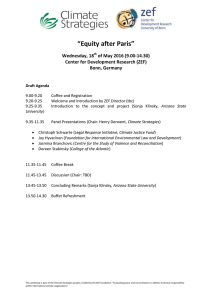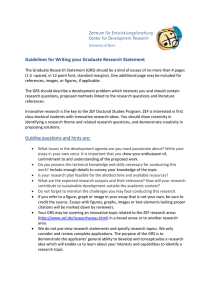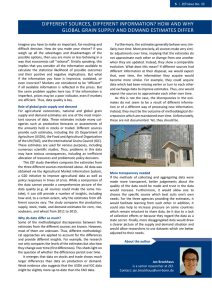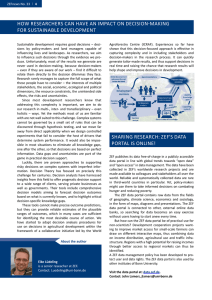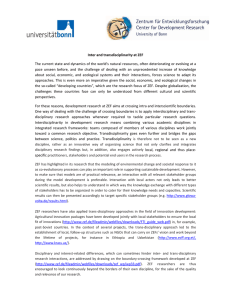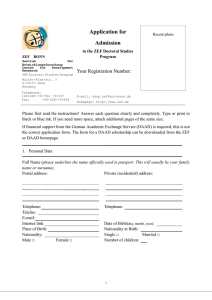ZEF P Po olliiccyy B
advertisement
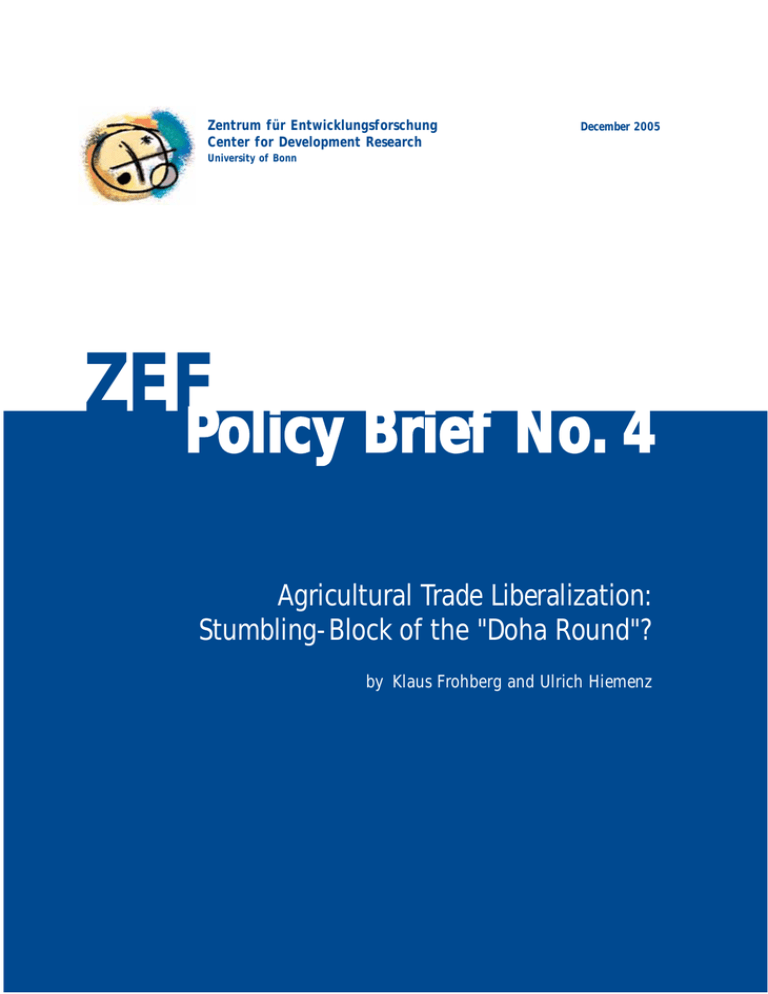
Zentrum für Entwicklungsforschung Center for Development Research December 2005 University of Bonn ZEFPolicy Brief No. 4 Agricultural Trade Liberalization: Stumbling-Block of the "Doha Round"? by Klaus Frohberg and Ulrich Hiemenz 1 ZEF Policy Brief No. 4 Center for Development Research (ZEF) Walter-Flex-Str. 3 - D-53113 Bonn - Germany Email: zef@uni-bonn.de - Internet: www.zef.de 2 ZEF Policy Brief No. 4 CHALLENGES & ANALYSIS What is at stake? Successive rounds of international trade negotiations have contributed to a considerable liberalization of international trade in goods and services, which is for the benefit of all countries participating in the process of globalization. The so-called Doha Round, launched in Doha, Qatar, in November 2001, is the ninth round of such negotiations since 1947. It is the first round since the General Agreement on Tariffs and Trade (GATT) with its roughly 30 high-income member countries was incorporated in the World Trade Organisation (WTO) in 1995. The WTO counts nearly 150 countries among its members. Based on the fact that the majority of WTO members are now developing countries, this new round was labelled "Development Round" and seeks "to put the needs and interests of these countries at the heart of the Programme adopted" (Ministerial Declaration, November 14 2001). The Doha Round focuses on three broad areas of international trade liberalization: reduced protection of agriculture, including subsidies and tariffs, improved market access for non-agricultural products, and services trade liberalization. However, at least since the WTO Ministerial Meeting in Cancun (September 2003) broke down, it has become clear that progress in negotiations can be achieved only on the basis of a reduced work programme. It is also clear that agriculture will make or break the Round, which is to be concluded successfully by the end of 2006. This goal can only be achieved if the 6th WTO Ministerial Meeting in Hong Kong, scheduled for December 13-18 2005, reaches agreement on at least the key parameters for the final stage of negotiations. A solution for the highly controversial issues related to agriculture should be at the heart of this agreement. If such an agreement is not achieved, the entire Doha Round will be put at risk. This could undermine the credibility of the system of international trade rules as agreed in the framework of the GATT and the WTO. Why so much attention to agriculture? The commitment to make Doha a "Development Round" is the major reason why agriculture plays such an important role in the negotiations. First, agriculture remains the most protected economic sector. Second, many developing countries enjoy a comparative advantage in agricultural production. And third, most poor people in poor coun- Agriculture remains the most protected economic sector. 3 ZEF Policy Brief No. 4 Most poor people in poor countries live in rural areas. tries live in rural areas. Thus, the removal of trade distortions in agricultural markets, which would benefit farmers in developing countries, can contribute to reducing poverty as stipulated in Goal 1 of the MDGs. From the perspective of developing countries, reducing protection of agriculture in high-income countries is a precondition for further negotiations on trade in manufactures and services. The EU and other OECD countries, on the other hand, do not seem to be prepared to offer less protection to their domestic agricultural sectors without concomitant progress in the other areas. What are the battle lines? Numerous studies have demonstrated the net benefits of a removal of all trade-distorting measures for developed and developing countries alike. The current controversy in the Doha Round is about the size and the sequence of reducing protection for 4 agriculture. In this debate, battle lines are being determined by the specific interests prevailing in different countries. Major players in the category of high-income countries are the US and the EU as well as the smaller countries with high agricultural protection such as Japan, Korea, or Switzerland, assembled in the G-10 group. Among developing countries, there are those with agricultural export interests, known as G-20. And finally, the G-90 group comprises the poorest developing countries known as "Least Developed Countries" (LDCs). The G90 group members are concerend about a potential erosion of their preferential access to markets of high-income countries (such as the "Everything But Arms" initiative of the EU) and pursue sector-specific interests (e.g. cotton). Current negotiations on agriculture focus on the rules and disciplines agreed in the July 2004 Framework Agreement. This Agreement includes, in particular, the three clearly identified "pillars" of market access, domestic support, and export subsidies. In these three areas, the major players have tabled new proposals in October to prepare for the Hong Kong Ministerial Meeting. The US started rolling the ball by proposing the elimination of all trade-distorting agricultural support measures, as well as tariffs, over a 15-year period starting in 2008. During the first 5 years, the proposal envisages significant reductions of domestic subsidies to agriculture in the range of 60-80 percent in high-income countries, a substantial improvement of market access by lowering tariffs by 55-90 percent, and a cap on the highest tariff lines of 75 percent. Two days later, the G-20 group proposed domestic subsidy reductions ranging from 70-80 percent, tariff cuts of up to 75 percent, and tariff caps of 100 percent for high-income ZEF Policy Brief No. 4 countries, with considerably lower reductions for developing countries. Finally, the European Trade Commissioner responded by offering up to 70 percent lower spending on subsidies, tariff cuts of 20-50 percent, and tariff caps of 100 percent. The latter continues to be opposed by the G-10 group, which has very high product-specific tariffs. These proposals were generally welcomed as going in the right direction, but substantial differences of opinion remain regarding access to agricultural markets in the EU and other high-income countries. In addition, the EU offer is conditional on progress in non-agricultural trade negotiations, which does not facilitate matters either, since it seems to demand up-front liberalization of industrial goods markets in exchange for lower agricultural protection in the future. All this does not bode well for the chances of finding a compromise acceptable to all parties in Hong Kong. But even if such a compromise is achieved, would it really serve the purpose of creating a level playing field for all participants in international agricultural markets? Some added concerns There are at least three reasons to doubt that this objective can be reached on the basis of the proposals on the table. These doubts are related to the following factors: the differences between bound and actual tariffs; domestic support levels for agriculture; the importance of middle-income developing countries - not only as exporters but also as importers of agricultural goods -, and the impact of liberalization on poor countries. South-South trade has become an important part of developing countries’ trade. All proposed cuts refer to bound rates of domestic support and tariffs. These bound rates are, however, so much higher than the actually applied rates, that even a cut in domestic support level in the range of 75 percent may not require countries with large subsidies such as the EU to take any action at all. Respective analyses show the same to be true in the area of market access. In 2001, the last year for which comparable data are available, bound tariffs were twice as high as applied tariffs in highincome countries. Hence, the EU would not have to reduce actually applied barriers to agricultural markets much under her own "liberalization formula". The huge gaps between bound and applied rates suggest indeed that welfare gains from such an agricultural liberalization would remain very limited. Most of the negotiations in the Doha Round have been framed in a North-South dimension, pitting developed against developing countries. However, South-South trade has become an important part of developing countries' trade. Unfortunately, numerous, notably larger middle-income developing countries such as Argentina, Brazil, India, or South Africa, have built up agricultural pro- 5 ZEF Policy Brief No. 4 tection levels similar to those in the US or the EU, thus hampering an expansion of trade among developing countries. These countries would need to contribute to the Round by offering some "concessions" regarding their own policies if the removal of agricultural trade distortions is to generate significant welfare gains for the group of developing countries as a whole. The G-90 group, finally, is very heterogeneous and includes many food-importing poor countries. They do not stand to gain from a removal of trade-distorting measures but may rather lose, because lower agricultural subsidies in OECD countries would result in higher world market prices for food products. To prevent such an undesirable outcome, poorer countries would have to be compensated by richer countries through transfers and/or be granted easier access to non-agricultural markets. This could more than offset any losses in agricultural markets as the respective estimates show. Prospects for Hong Kong The success of the Doha Round hinges on finding a compromise for the difficult issues related to agricultural protectionism in developed and developing countries alike. Given the current state of preparatory negotiations, it is not likely that such a compromise will emerge in Hong Kong. Negotiators from the various groupings are too far apart to be able to agree on much more than a progress report. This is a pity, especially from the viewpoint of developing countries. Another chance to change the global trade rules in favor of poorer countries will be squandered in the hope of find- 6 A positive outcome of the Doha Round is urgently required. ing a solution later. Extending negotiations beyond 2006 is, however, not really promising, since the US President's so-called "trade promotion authority" (fast track) expires in mid-2007 and is not likely to be renewed by the US Congress. In addition, any compromise must also extend to non-agricultural trade liberalization. This is a precondition for all countries, including the poorer ones, to benefit from the outcome of the Round. This is a tall order, but, to be on the positive side, no previous round has ever failed to reach a conclusion. A positive outcome is all the more urgent as a failure could seriously undermine the credibility of the WTO and the political commitment, especially of the larger, richer countries, to abide by its rules and disciplines. That would be very dangerous for the smaller, poorer countries that benefit disproportionately from a system based on rules rather than on power. ZEF Policy Brief No. 4 ZEFPolicy Brief For the purpose of applied research the ZEF Policy Briefs mainly address decision makers and practitioners of development cooperation with pointed comments on current and emerging topics. The ZEF Policy Briefs are published sporadically. They are complementary to ZEF’s more extensive Discussion Papers that intend to stimulate discussion among researchers and practitioners. 7 ZEF Policy Brief No. 4 The Center for Development Research (ZEF) is an international and interdisciplinary research institute at the Rheinische Friedrich-Wilhelms-University, Bonn. The Center came into actual operation towards the end of 1997. The work of the Center is supported by an external International Advisory Board, currently chaired by Prof. Klaus Töpfer, Director General of the United Nations Environment Program (UNEP), Kenya. The Board monitors and evaluates ZEF´s work. IMPRINT Published by: Zentrum für Entwicklungsforschung (ZEF) Center for Development Research University of Bonn Walter-Flex-Strasse 3 D - 53113 Bonn Germany Phone: +49-228-73-1846 Fax: +49-228-73-1889 E-Mail: zef@uni-bonn.de http://www.zef.de Authors: Klaus Frohberg (Director of ZEF’s Department of Economic and Technological Change) and Ulrich Hiemenz (Senior Researcher at ZEF) Copyright © 2005 Center for Development Research. All rights reserved. Sections of this document may be reproduced without the express permission, but with acknowledgement of the Center for Development Research. 8 Editor: Alma van der Veen Layout: Katharina Moraht Print: Druckerei Brandt GmbH, Bonn Photos: ZEF

